SAIC Motor: Incoterms, Carrier Selection, and Distribution Strategies
VerifiedAdded on 2020/04/21
|12
|2733
|209
Report
AI Summary
This report examines the transport and distribution strategies of SAIC Motor, a major Chinese automotive manufacturer. It identifies and recommends suitable incoterms, specifically DAT and FCA, for optimizing international product distribution and minimizing associated risks and costs. The report emphasizes the significance of carrier selection, highlighting key factors such as geographic coverage, reliability, equipment availability, and transit time. Moreover, it underscores the importance of carrier relationship management, advocating for long-term partnerships to foster trust, transparency, and shared profitability, ultimately enhancing efficiency and creating value. The analysis concludes that strategic choices in incoterms and carrier relationships are crucial for SAIC Motor's successful international operations.
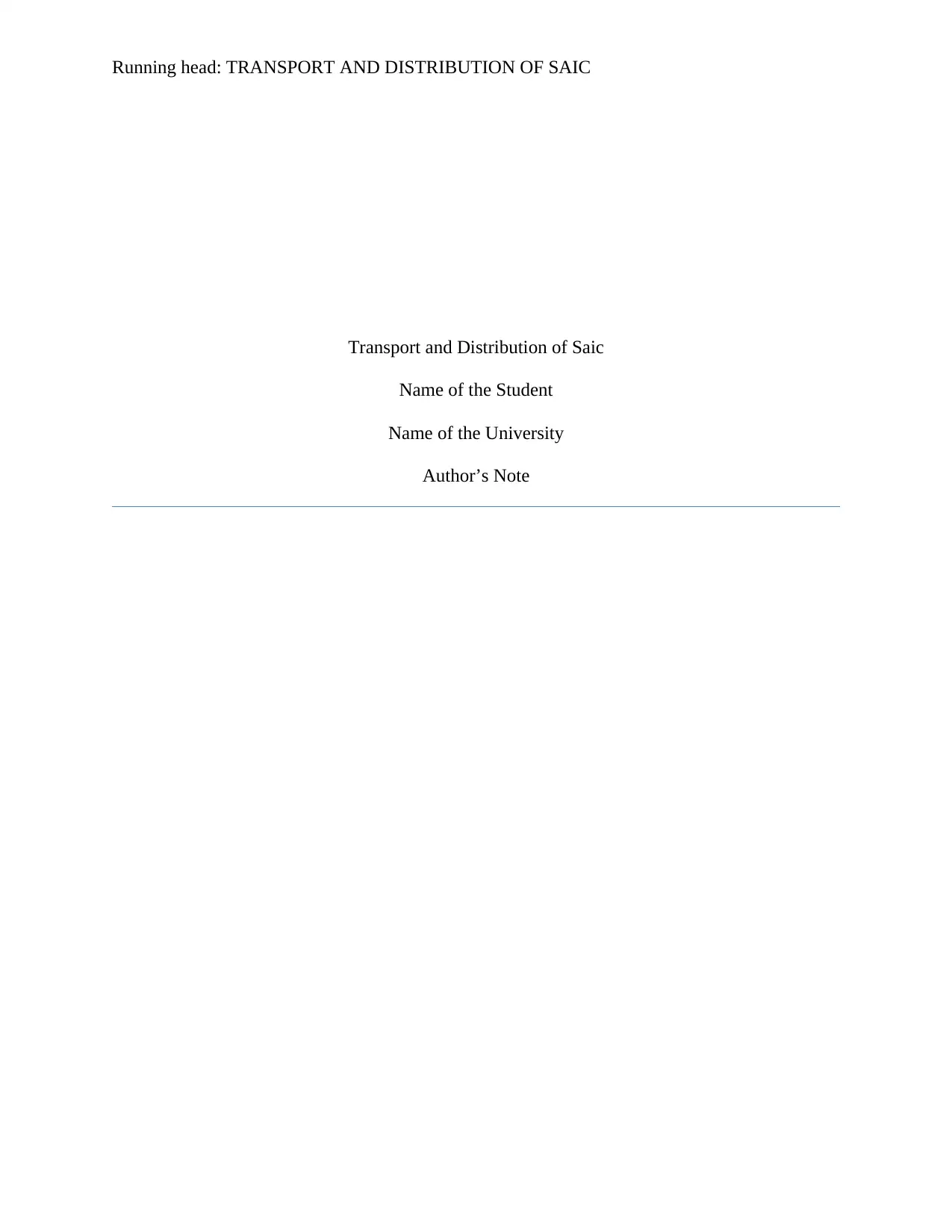
Running head: TRANSPORT AND DISTRIBUTION OF SAIC
Transport and Distribution of Saic
Name of the Student
Name of the University
Author’s Note
Transport and Distribution of Saic
Name of the Student
Name of the University
Author’s Note
Paraphrase This Document
Need a fresh take? Get an instant paraphrase of this document with our AI Paraphraser
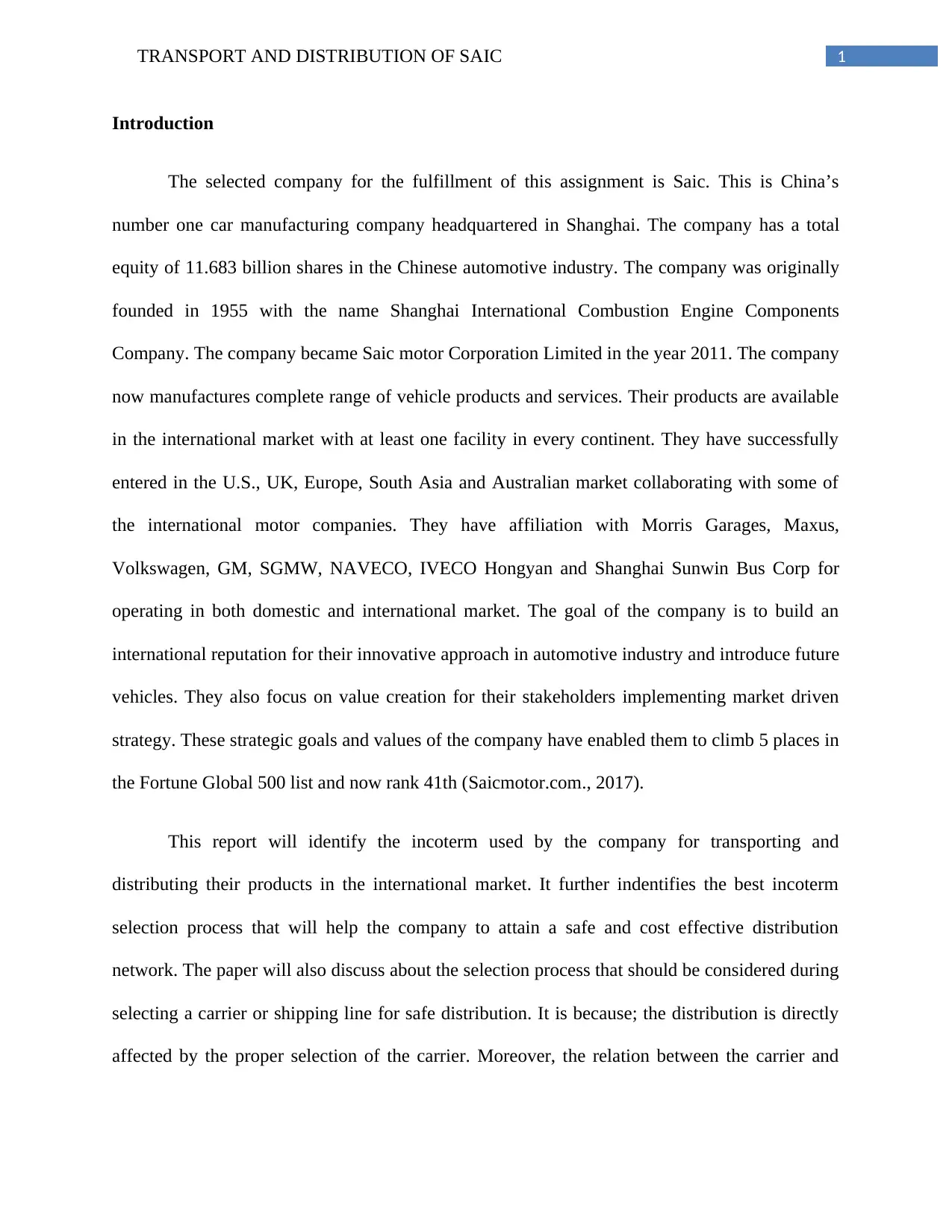
1TRANSPORT AND DISTRIBUTION OF SAIC
Introduction
The selected company for the fulfillment of this assignment is Saic. This is China’s
number one car manufacturing company headquartered in Shanghai. The company has a total
equity of 11.683 billion shares in the Chinese automotive industry. The company was originally
founded in 1955 with the name Shanghai International Combustion Engine Components
Company. The company became Saic motor Corporation Limited in the year 2011. The company
now manufactures complete range of vehicle products and services. Their products are available
in the international market with at least one facility in every continent. They have successfully
entered in the U.S., UK, Europe, South Asia and Australian market collaborating with some of
the international motor companies. They have affiliation with Morris Garages, Maxus,
Volkswagen, GM, SGMW, NAVECO, IVECO Hongyan and Shanghai Sunwin Bus Corp for
operating in both domestic and international market. The goal of the company is to build an
international reputation for their innovative approach in automotive industry and introduce future
vehicles. They also focus on value creation for their stakeholders implementing market driven
strategy. These strategic goals and values of the company have enabled them to climb 5 places in
the Fortune Global 500 list and now rank 41th (Saicmotor.com., 2017).
This report will identify the incoterm used by the company for transporting and
distributing their products in the international market. It further indentifies the best incoterm
selection process that will help the company to attain a safe and cost effective distribution
network. The paper will also discuss about the selection process that should be considered during
selecting a carrier or shipping line for safe distribution. It is because; the distribution is directly
affected by the proper selection of the carrier. Moreover, the relation between the carrier and
Introduction
The selected company for the fulfillment of this assignment is Saic. This is China’s
number one car manufacturing company headquartered in Shanghai. The company has a total
equity of 11.683 billion shares in the Chinese automotive industry. The company was originally
founded in 1955 with the name Shanghai International Combustion Engine Components
Company. The company became Saic motor Corporation Limited in the year 2011. The company
now manufactures complete range of vehicle products and services. Their products are available
in the international market with at least one facility in every continent. They have successfully
entered in the U.S., UK, Europe, South Asia and Australian market collaborating with some of
the international motor companies. They have affiliation with Morris Garages, Maxus,
Volkswagen, GM, SGMW, NAVECO, IVECO Hongyan and Shanghai Sunwin Bus Corp for
operating in both domestic and international market. The goal of the company is to build an
international reputation for their innovative approach in automotive industry and introduce future
vehicles. They also focus on value creation for their stakeholders implementing market driven
strategy. These strategic goals and values of the company have enabled them to climb 5 places in
the Fortune Global 500 list and now rank 41th (Saicmotor.com., 2017).
This report will identify the incoterm used by the company for transporting and
distributing their products in the international market. It further indentifies the best incoterm
selection process that will help the company to attain a safe and cost effective distribution
network. The paper will also discuss about the selection process that should be considered during
selecting a carrier or shipping line for safe distribution. It is because; the distribution is directly
affected by the proper selection of the carrier. Moreover, the relation between the carrier and
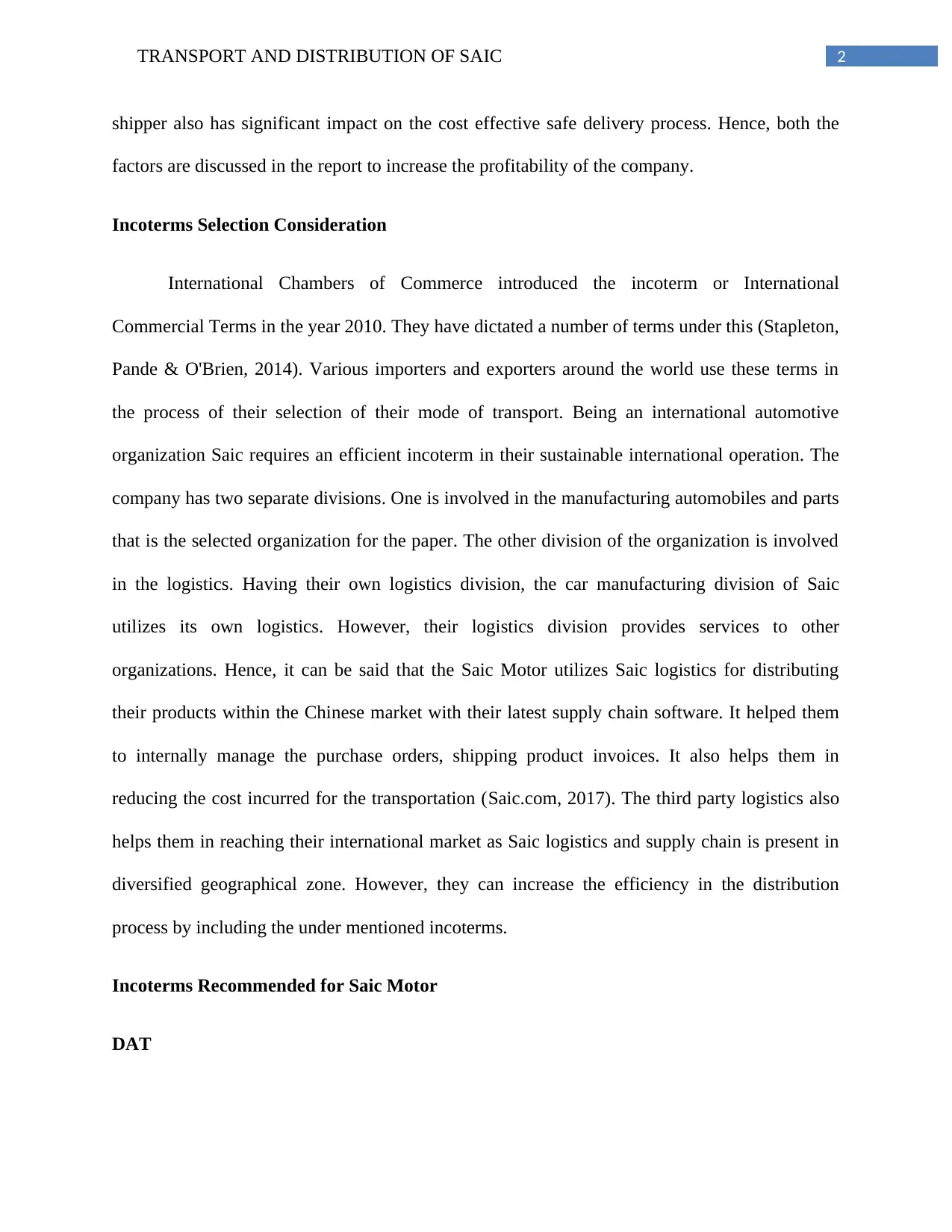
2TRANSPORT AND DISTRIBUTION OF SAIC
shipper also has significant impact on the cost effective safe delivery process. Hence, both the
factors are discussed in the report to increase the profitability of the company.
Incoterms Selection Consideration
International Chambers of Commerce introduced the incoterm or International
Commercial Terms in the year 2010. They have dictated a number of terms under this (Stapleton,
Pande & O'Brien, 2014). Various importers and exporters around the world use these terms in
the process of their selection of their mode of transport. Being an international automotive
organization Saic requires an efficient incoterm in their sustainable international operation. The
company has two separate divisions. One is involved in the manufacturing automobiles and parts
that is the selected organization for the paper. The other division of the organization is involved
in the logistics. Having their own logistics division, the car manufacturing division of Saic
utilizes its own logistics. However, their logistics division provides services to other
organizations. Hence, it can be said that the Saic Motor utilizes Saic logistics for distributing
their products within the Chinese market with their latest supply chain software. It helped them
to internally manage the purchase orders, shipping product invoices. It also helps them in
reducing the cost incurred for the transportation (Saic.com, 2017). The third party logistics also
helps them in reaching their international market as Saic logistics and supply chain is present in
diversified geographical zone. However, they can increase the efficiency in the distribution
process by including the under mentioned incoterms.
Incoterms Recommended for Saic Motor
DAT
shipper also has significant impact on the cost effective safe delivery process. Hence, both the
factors are discussed in the report to increase the profitability of the company.
Incoterms Selection Consideration
International Chambers of Commerce introduced the incoterm or International
Commercial Terms in the year 2010. They have dictated a number of terms under this (Stapleton,
Pande & O'Brien, 2014). Various importers and exporters around the world use these terms in
the process of their selection of their mode of transport. Being an international automotive
organization Saic requires an efficient incoterm in their sustainable international operation. The
company has two separate divisions. One is involved in the manufacturing automobiles and parts
that is the selected organization for the paper. The other division of the organization is involved
in the logistics. Having their own logistics division, the car manufacturing division of Saic
utilizes its own logistics. However, their logistics division provides services to other
organizations. Hence, it can be said that the Saic Motor utilizes Saic logistics for distributing
their products within the Chinese market with their latest supply chain software. It helped them
to internally manage the purchase orders, shipping product invoices. It also helps them in
reducing the cost incurred for the transportation (Saic.com, 2017). The third party logistics also
helps them in reaching their international market as Saic logistics and supply chain is present in
diversified geographical zone. However, they can increase the efficiency in the distribution
process by including the under mentioned incoterms.
Incoterms Recommended for Saic Motor
DAT
⊘ This is a preview!⊘
Do you want full access?
Subscribe today to unlock all pages.

Trusted by 1+ million students worldwide
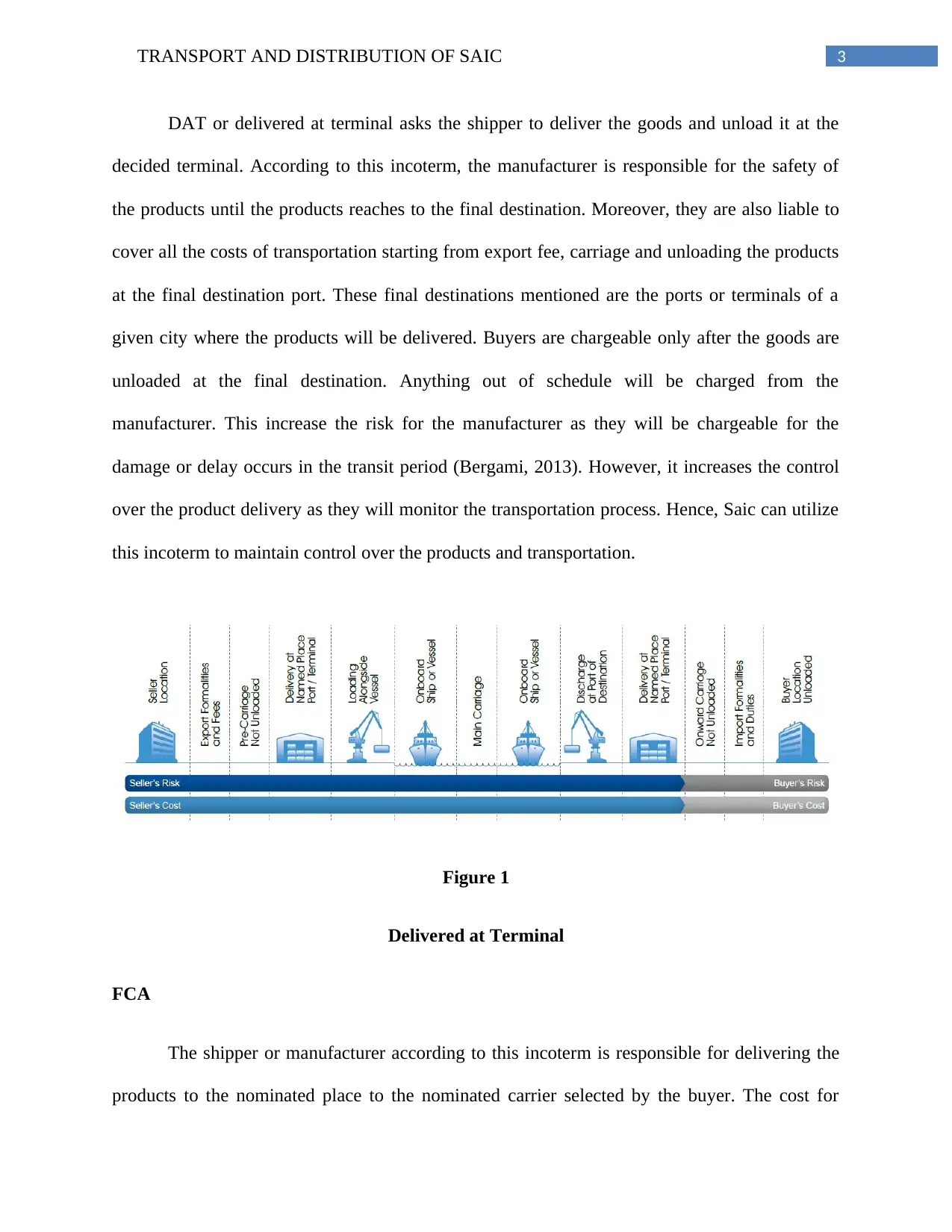
3TRANSPORT AND DISTRIBUTION OF SAIC
DAT or delivered at terminal asks the shipper to deliver the goods and unload it at the
decided terminal. According to this incoterm, the manufacturer is responsible for the safety of
the products until the products reaches to the final destination. Moreover, they are also liable to
cover all the costs of transportation starting from export fee, carriage and unloading the products
at the final destination port. These final destinations mentioned are the ports or terminals of a
given city where the products will be delivered. Buyers are chargeable only after the goods are
unloaded at the final destination. Anything out of schedule will be charged from the
manufacturer. This increase the risk for the manufacturer as they will be chargeable for the
damage or delay occurs in the transit period (Bergami, 2013). However, it increases the control
over the product delivery as they will monitor the transportation process. Hence, Saic can utilize
this incoterm to maintain control over the products and transportation.
Figure 1
Delivered at Terminal
FCA
The shipper or manufacturer according to this incoterm is responsible for delivering the
products to the nominated place to the nominated carrier selected by the buyer. The cost for
DAT or delivered at terminal asks the shipper to deliver the goods and unload it at the
decided terminal. According to this incoterm, the manufacturer is responsible for the safety of
the products until the products reaches to the final destination. Moreover, they are also liable to
cover all the costs of transportation starting from export fee, carriage and unloading the products
at the final destination port. These final destinations mentioned are the ports or terminals of a
given city where the products will be delivered. Buyers are chargeable only after the goods are
unloaded at the final destination. Anything out of schedule will be charged from the
manufacturer. This increase the risk for the manufacturer as they will be chargeable for the
damage or delay occurs in the transit period (Bergami, 2013). However, it increases the control
over the product delivery as they will monitor the transportation process. Hence, Saic can utilize
this incoterm to maintain control over the products and transportation.
Figure 1
Delivered at Terminal
FCA
The shipper or manufacturer according to this incoterm is responsible for delivering the
products to the nominated place to the nominated carrier selected by the buyer. The cost for
Paraphrase This Document
Need a fresh take? Get an instant paraphrase of this document with our AI Paraphraser
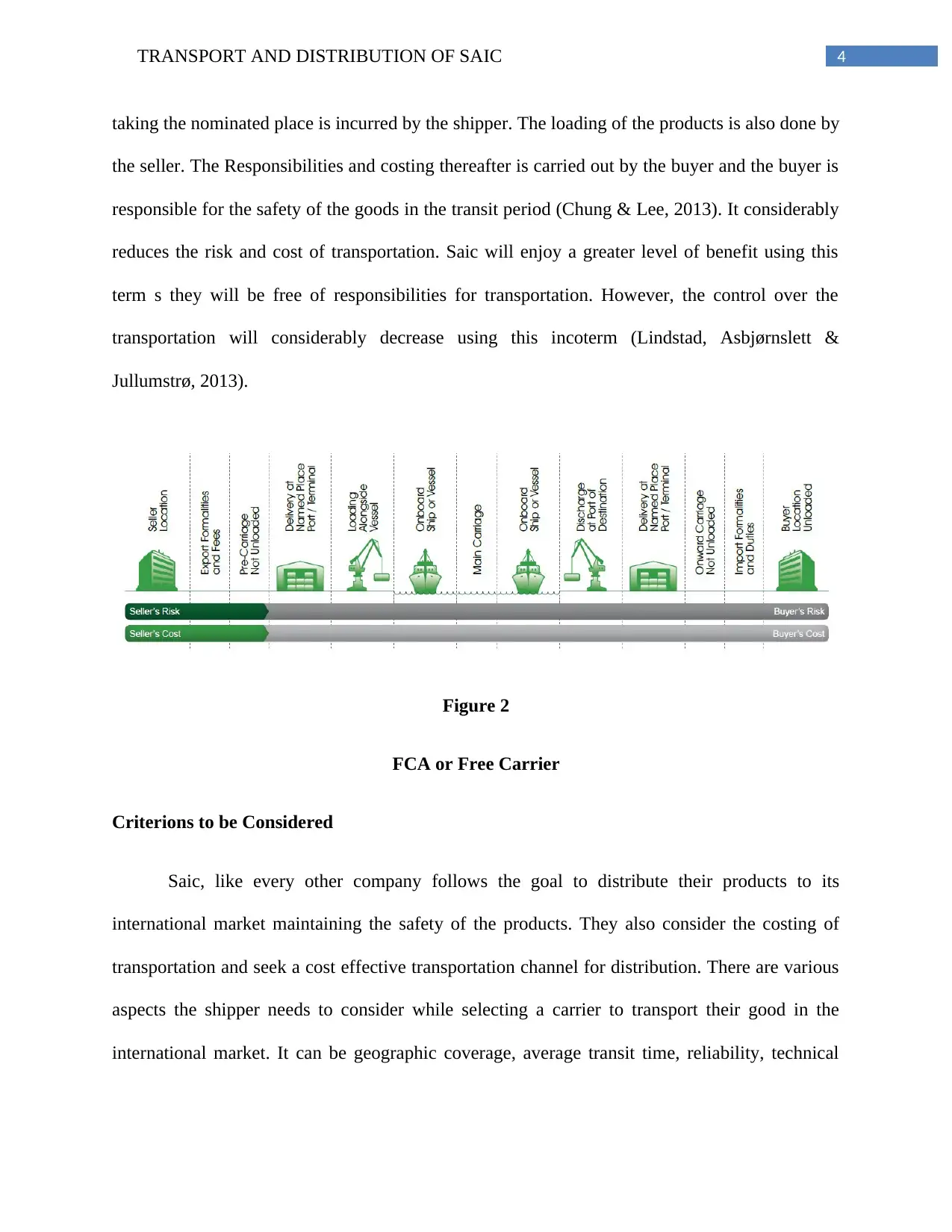
4TRANSPORT AND DISTRIBUTION OF SAIC
taking the nominated place is incurred by the shipper. The loading of the products is also done by
the seller. The Responsibilities and costing thereafter is carried out by the buyer and the buyer is
responsible for the safety of the goods in the transit period (Chung & Lee, 2013). It considerably
reduces the risk and cost of transportation. Saic will enjoy a greater level of benefit using this
term s they will be free of responsibilities for transportation. However, the control over the
transportation will considerably decrease using this incoterm (Lindstad, Asbjørnslett &
Jullumstrø, 2013).
Figure 2
FCA or Free Carrier
Criterions to be Considered
Saic, like every other company follows the goal to distribute their products to its
international market maintaining the safety of the products. They also consider the costing of
transportation and seek a cost effective transportation channel for distribution. There are various
aspects the shipper needs to consider while selecting a carrier to transport their good in the
international market. It can be geographic coverage, average transit time, reliability, technical
taking the nominated place is incurred by the shipper. The loading of the products is also done by
the seller. The Responsibilities and costing thereafter is carried out by the buyer and the buyer is
responsible for the safety of the goods in the transit period (Chung & Lee, 2013). It considerably
reduces the risk and cost of transportation. Saic will enjoy a greater level of benefit using this
term s they will be free of responsibilities for transportation. However, the control over the
transportation will considerably decrease using this incoterm (Lindstad, Asbjørnslett &
Jullumstrø, 2013).
Figure 2
FCA or Free Carrier
Criterions to be Considered
Saic, like every other company follows the goal to distribute their products to its
international market maintaining the safety of the products. They also consider the costing of
transportation and seek a cost effective transportation channel for distribution. There are various
aspects the shipper needs to consider while selecting a carrier to transport their good in the
international market. It can be geographic coverage, average transit time, reliability, technical
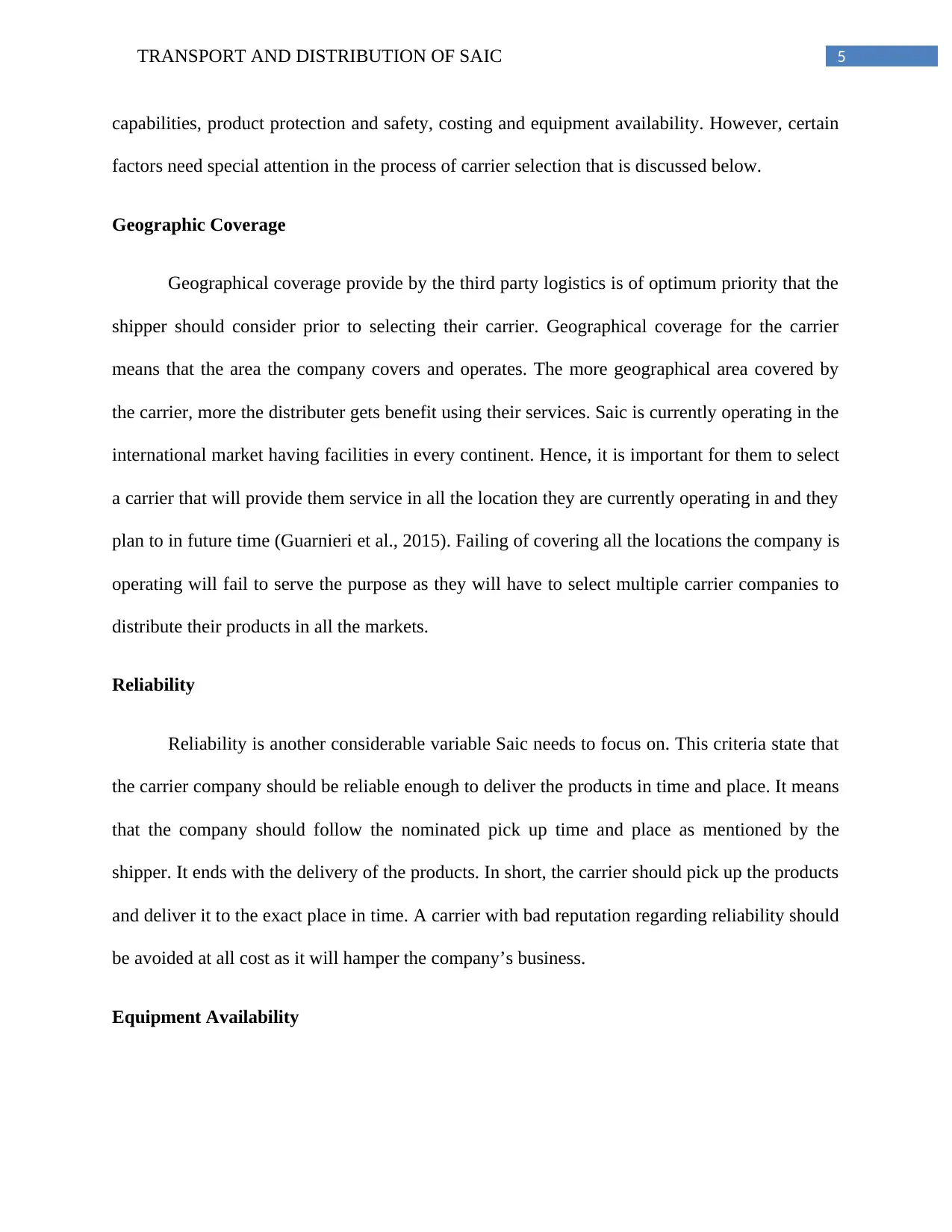
5TRANSPORT AND DISTRIBUTION OF SAIC
capabilities, product protection and safety, costing and equipment availability. However, certain
factors need special attention in the process of carrier selection that is discussed below.
Geographic Coverage
Geographical coverage provide by the third party logistics is of optimum priority that the
shipper should consider prior to selecting their carrier. Geographical coverage for the carrier
means that the area the company covers and operates. The more geographical area covered by
the carrier, more the distributer gets benefit using their services. Saic is currently operating in the
international market having facilities in every continent. Hence, it is important for them to select
a carrier that will provide them service in all the location they are currently operating in and they
plan to in future time (Guarnieri et al., 2015). Failing of covering all the locations the company is
operating will fail to serve the purpose as they will have to select multiple carrier companies to
distribute their products in all the markets.
Reliability
Reliability is another considerable variable Saic needs to focus on. This criteria state that
the carrier company should be reliable enough to deliver the products in time and place. It means
that the company should follow the nominated pick up time and place as mentioned by the
shipper. It ends with the delivery of the products. In short, the carrier should pick up the products
and deliver it to the exact place in time. A carrier with bad reputation regarding reliability should
be avoided at all cost as it will hamper the company’s business.
Equipment Availability
capabilities, product protection and safety, costing and equipment availability. However, certain
factors need special attention in the process of carrier selection that is discussed below.
Geographic Coverage
Geographical coverage provide by the third party logistics is of optimum priority that the
shipper should consider prior to selecting their carrier. Geographical coverage for the carrier
means that the area the company covers and operates. The more geographical area covered by
the carrier, more the distributer gets benefit using their services. Saic is currently operating in the
international market having facilities in every continent. Hence, it is important for them to select
a carrier that will provide them service in all the location they are currently operating in and they
plan to in future time (Guarnieri et al., 2015). Failing of covering all the locations the company is
operating will fail to serve the purpose as they will have to select multiple carrier companies to
distribute their products in all the markets.
Reliability
Reliability is another considerable variable Saic needs to focus on. This criteria state that
the carrier company should be reliable enough to deliver the products in time and place. It means
that the company should follow the nominated pick up time and place as mentioned by the
shipper. It ends with the delivery of the products. In short, the carrier should pick up the products
and deliver it to the exact place in time. A carrier with bad reputation regarding reliability should
be avoided at all cost as it will hamper the company’s business.
Equipment Availability
⊘ This is a preview!⊘
Do you want full access?
Subscribe today to unlock all pages.

Trusted by 1+ million students worldwide
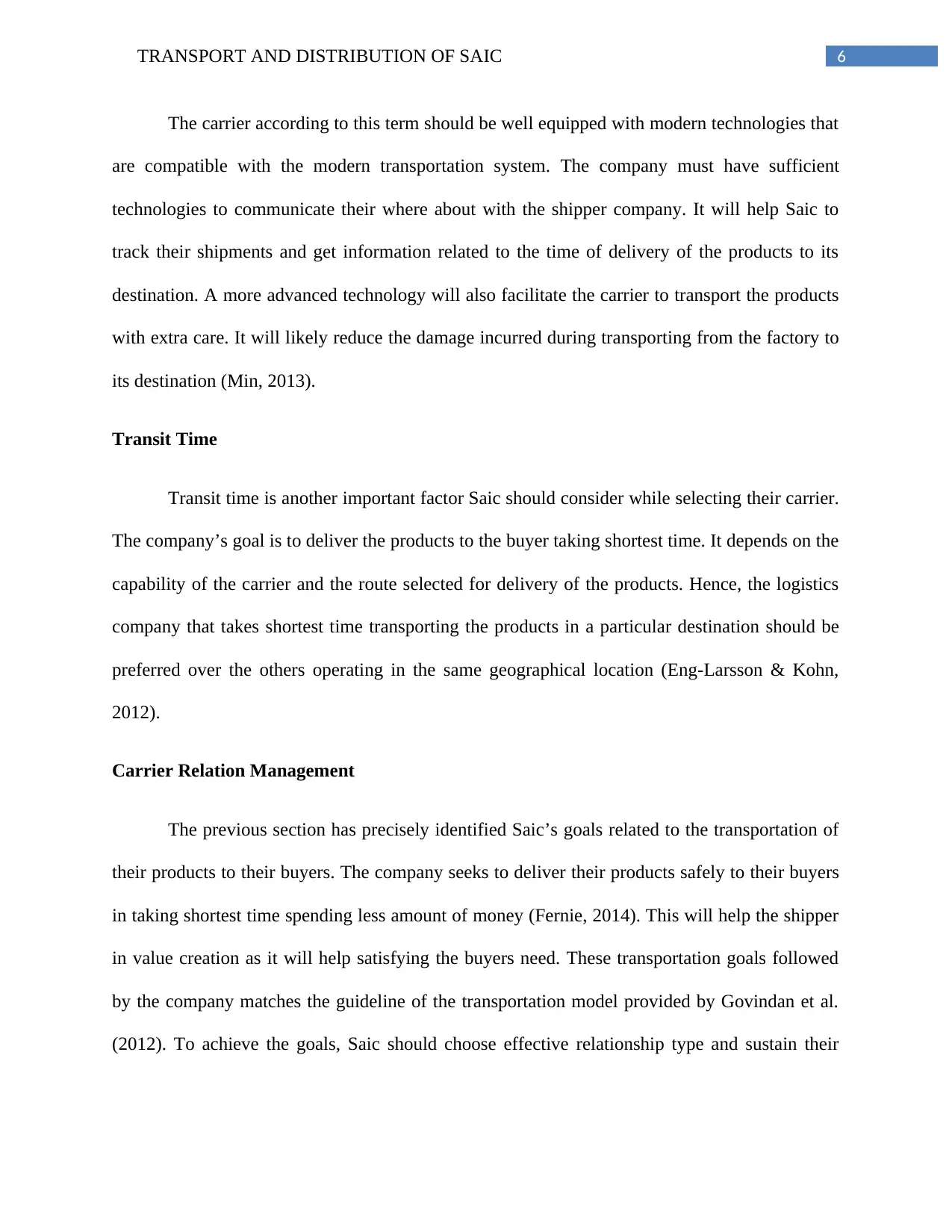
6TRANSPORT AND DISTRIBUTION OF SAIC
The carrier according to this term should be well equipped with modern technologies that
are compatible with the modern transportation system. The company must have sufficient
technologies to communicate their where about with the shipper company. It will help Saic to
track their shipments and get information related to the time of delivery of the products to its
destination. A more advanced technology will also facilitate the carrier to transport the products
with extra care. It will likely reduce the damage incurred during transporting from the factory to
its destination (Min, 2013).
Transit Time
Transit time is another important factor Saic should consider while selecting their carrier.
The company’s goal is to deliver the products to the buyer taking shortest time. It depends on the
capability of the carrier and the route selected for delivery of the products. Hence, the logistics
company that takes shortest time transporting the products in a particular destination should be
preferred over the others operating in the same geographical location (Eng-Larsson & Kohn,
2012).
Carrier Relation Management
The previous section has precisely identified Saic’s goals related to the transportation of
their products to their buyers. The company seeks to deliver their products safely to their buyers
in taking shortest time spending less amount of money (Fernie, 2014). This will help the shipper
in value creation as it will help satisfying the buyers need. These transportation goals followed
by the company matches the guideline of the transportation model provided by Govindan et al.
(2012). To achieve the goals, Saic should choose effective relationship type and sustain their
The carrier according to this term should be well equipped with modern technologies that
are compatible with the modern transportation system. The company must have sufficient
technologies to communicate their where about with the shipper company. It will help Saic to
track their shipments and get information related to the time of delivery of the products to its
destination. A more advanced technology will also facilitate the carrier to transport the products
with extra care. It will likely reduce the damage incurred during transporting from the factory to
its destination (Min, 2013).
Transit Time
Transit time is another important factor Saic should consider while selecting their carrier.
The company’s goal is to deliver the products to the buyer taking shortest time. It depends on the
capability of the carrier and the route selected for delivery of the products. Hence, the logistics
company that takes shortest time transporting the products in a particular destination should be
preferred over the others operating in the same geographical location (Eng-Larsson & Kohn,
2012).
Carrier Relation Management
The previous section has precisely identified Saic’s goals related to the transportation of
their products to their buyers. The company seeks to deliver their products safely to their buyers
in taking shortest time spending less amount of money (Fernie, 2014). This will help the shipper
in value creation as it will help satisfying the buyers need. These transportation goals followed
by the company matches the guideline of the transportation model provided by Govindan et al.
(2012). To achieve the goals, Saic should choose effective relationship type and sustain their
Paraphrase This Document
Need a fresh take? Get an instant paraphrase of this document with our AI Paraphraser
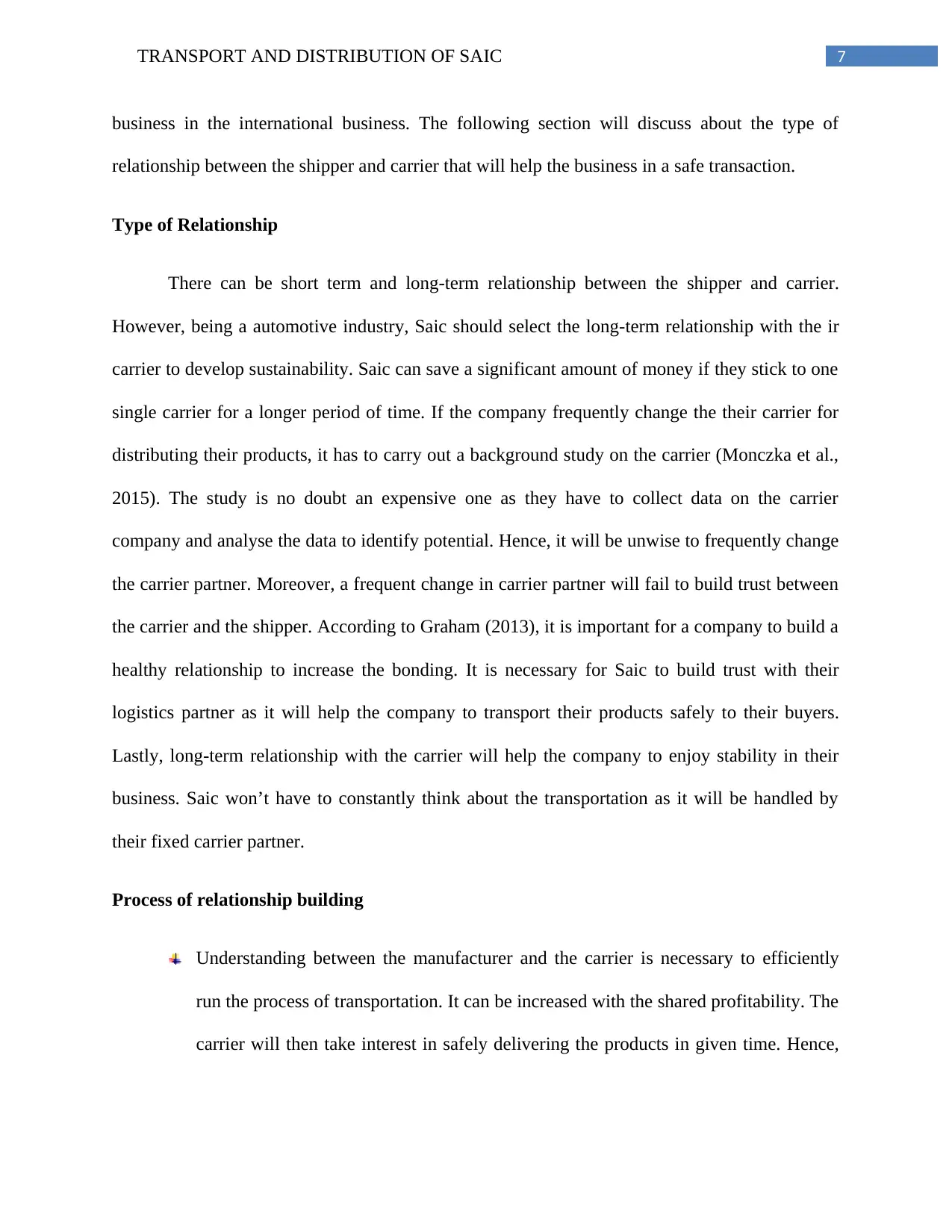
7TRANSPORT AND DISTRIBUTION OF SAIC
business in the international business. The following section will discuss about the type of
relationship between the shipper and carrier that will help the business in a safe transaction.
Type of Relationship
There can be short term and long-term relationship between the shipper and carrier.
However, being a automotive industry, Saic should select the long-term relationship with the ir
carrier to develop sustainability. Saic can save a significant amount of money if they stick to one
single carrier for a longer period of time. If the company frequently change the their carrier for
distributing their products, it has to carry out a background study on the carrier (Monczka et al.,
2015). The study is no doubt an expensive one as they have to collect data on the carrier
company and analyse the data to identify potential. Hence, it will be unwise to frequently change
the carrier partner. Moreover, a frequent change in carrier partner will fail to build trust between
the carrier and the shipper. According to Graham (2013), it is important for a company to build a
healthy relationship to increase the bonding. It is necessary for Saic to build trust with their
logistics partner as it will help the company to transport their products safely to their buyers.
Lastly, long-term relationship with the carrier will help the company to enjoy stability in their
business. Saic won’t have to constantly think about the transportation as it will be handled by
their fixed carrier partner.
Process of relationship building
Understanding between the manufacturer and the carrier is necessary to efficiently
run the process of transportation. It can be increased with the shared profitability. The
carrier will then take interest in safely delivering the products in given time. Hence,
business in the international business. The following section will discuss about the type of
relationship between the shipper and carrier that will help the business in a safe transaction.
Type of Relationship
There can be short term and long-term relationship between the shipper and carrier.
However, being a automotive industry, Saic should select the long-term relationship with the ir
carrier to develop sustainability. Saic can save a significant amount of money if they stick to one
single carrier for a longer period of time. If the company frequently change the their carrier for
distributing their products, it has to carry out a background study on the carrier (Monczka et al.,
2015). The study is no doubt an expensive one as they have to collect data on the carrier
company and analyse the data to identify potential. Hence, it will be unwise to frequently change
the carrier partner. Moreover, a frequent change in carrier partner will fail to build trust between
the carrier and the shipper. According to Graham (2013), it is important for a company to build a
healthy relationship to increase the bonding. It is necessary for Saic to build trust with their
logistics partner as it will help the company to transport their products safely to their buyers.
Lastly, long-term relationship with the carrier will help the company to enjoy stability in their
business. Saic won’t have to constantly think about the transportation as it will be handled by
their fixed carrier partner.
Process of relationship building
Understanding between the manufacturer and the carrier is necessary to efficiently
run the process of transportation. It can be increased with the shared profitability. The
carrier will then take interest in safely delivering the products in given time. Hence,
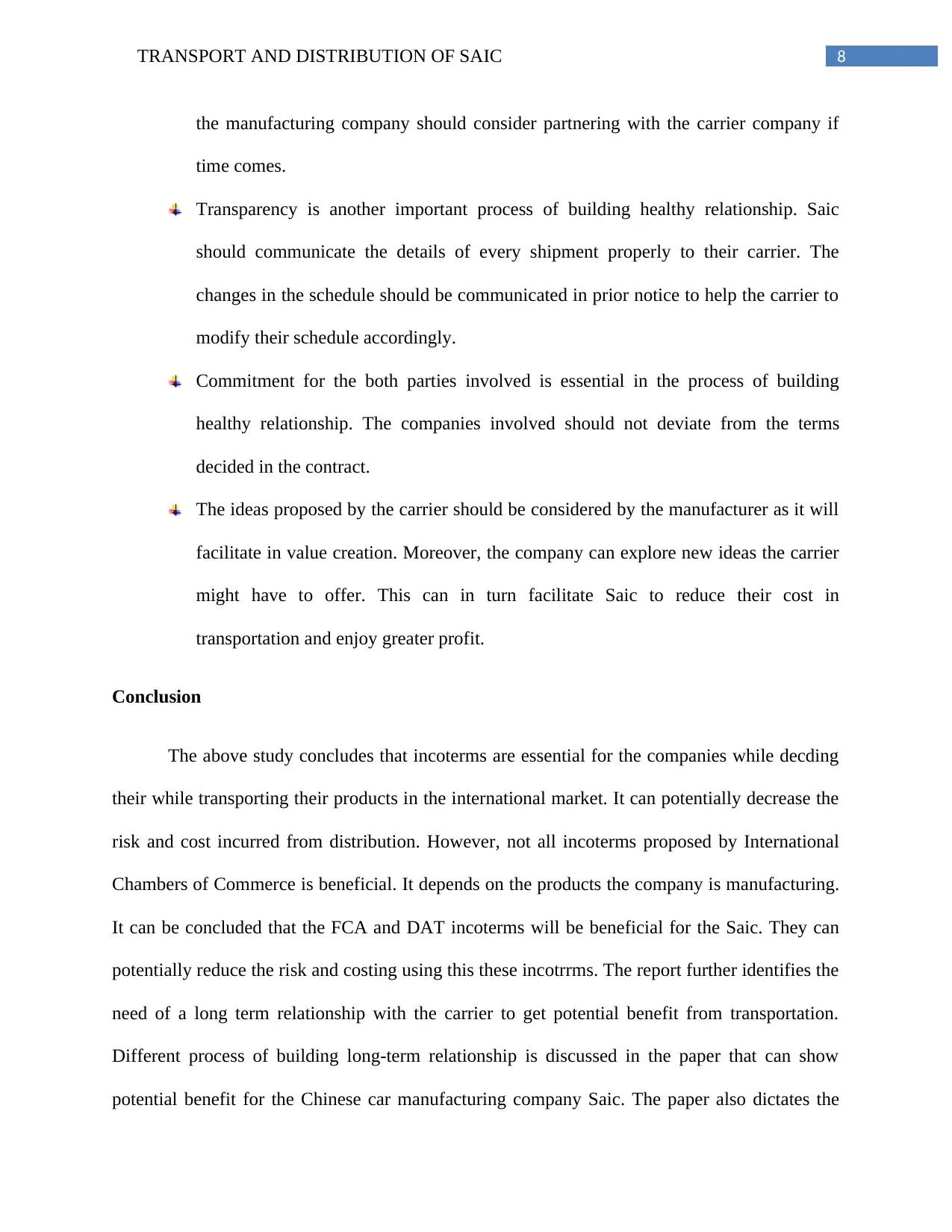
8TRANSPORT AND DISTRIBUTION OF SAIC
the manufacturing company should consider partnering with the carrier company if
time comes.
Transparency is another important process of building healthy relationship. Saic
should communicate the details of every shipment properly to their carrier. The
changes in the schedule should be communicated in prior notice to help the carrier to
modify their schedule accordingly.
Commitment for the both parties involved is essential in the process of building
healthy relationship. The companies involved should not deviate from the terms
decided in the contract.
The ideas proposed by the carrier should be considered by the manufacturer as it will
facilitate in value creation. Moreover, the company can explore new ideas the carrier
might have to offer. This can in turn facilitate Saic to reduce their cost in
transportation and enjoy greater profit.
Conclusion
The above study concludes that incoterms are essential for the companies while decding
their while transporting their products in the international market. It can potentially decrease the
risk and cost incurred from distribution. However, not all incoterms proposed by International
Chambers of Commerce is beneficial. It depends on the products the company is manufacturing.
It can be concluded that the FCA and DAT incoterms will be beneficial for the Saic. They can
potentially reduce the risk and costing using this these incotrrms. The report further identifies the
need of a long term relationship with the carrier to get potential benefit from transportation.
Different process of building long-term relationship is discussed in the paper that can show
potential benefit for the Chinese car manufacturing company Saic. The paper also dictates the
the manufacturing company should consider partnering with the carrier company if
time comes.
Transparency is another important process of building healthy relationship. Saic
should communicate the details of every shipment properly to their carrier. The
changes in the schedule should be communicated in prior notice to help the carrier to
modify their schedule accordingly.
Commitment for the both parties involved is essential in the process of building
healthy relationship. The companies involved should not deviate from the terms
decided in the contract.
The ideas proposed by the carrier should be considered by the manufacturer as it will
facilitate in value creation. Moreover, the company can explore new ideas the carrier
might have to offer. This can in turn facilitate Saic to reduce their cost in
transportation and enjoy greater profit.
Conclusion
The above study concludes that incoterms are essential for the companies while decding
their while transporting their products in the international market. It can potentially decrease the
risk and cost incurred from distribution. However, not all incoterms proposed by International
Chambers of Commerce is beneficial. It depends on the products the company is manufacturing.
It can be concluded that the FCA and DAT incoterms will be beneficial for the Saic. They can
potentially reduce the risk and costing using this these incotrrms. The report further identifies the
need of a long term relationship with the carrier to get potential benefit from transportation.
Different process of building long-term relationship is discussed in the paper that can show
potential benefit for the Chinese car manufacturing company Saic. The paper also dictates the
⊘ This is a preview!⊘
Do you want full access?
Subscribe today to unlock all pages.

Trusted by 1+ million students worldwide
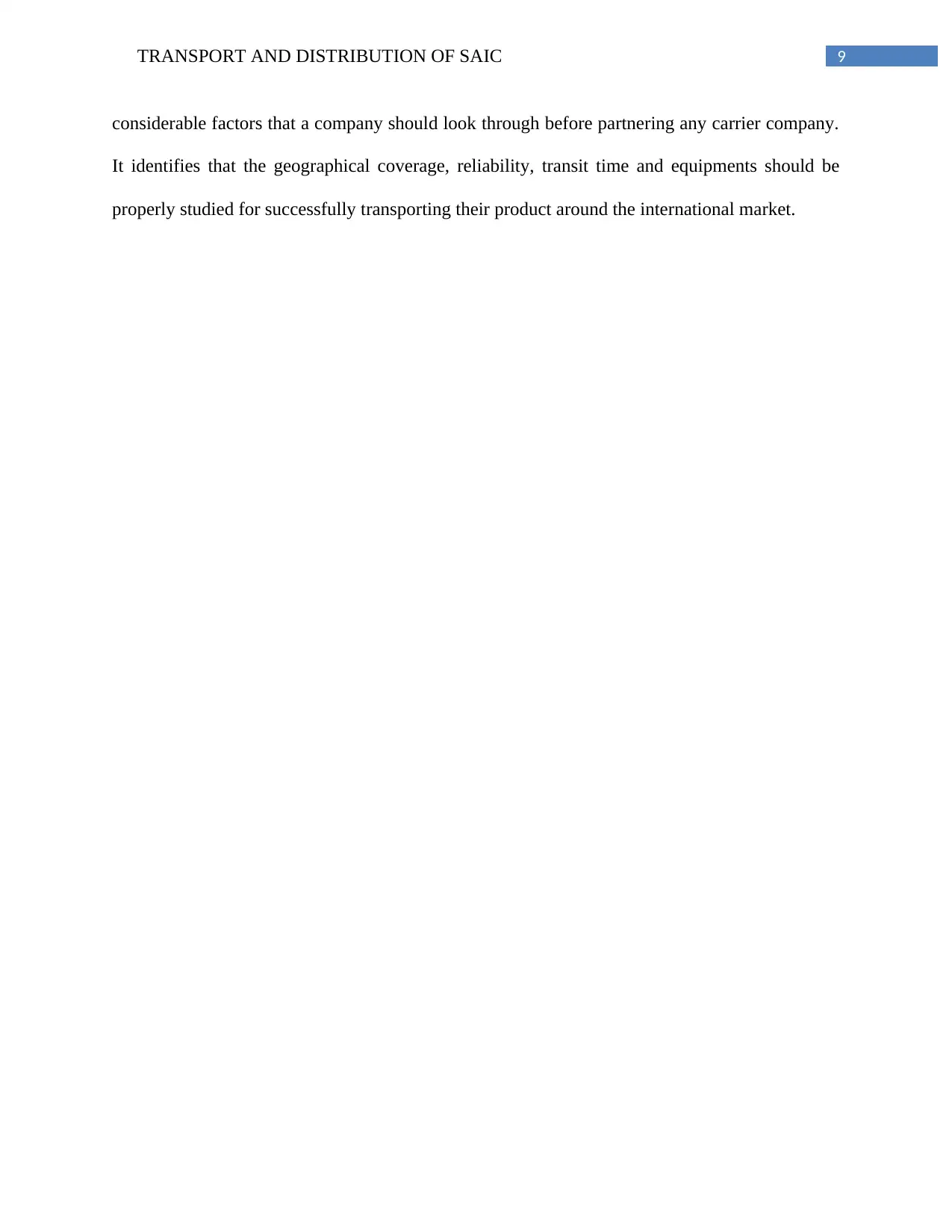
9TRANSPORT AND DISTRIBUTION OF SAIC
considerable factors that a company should look through before partnering any carrier company.
It identifies that the geographical coverage, reliability, transit time and equipments should be
properly studied for successfully transporting their product around the international market.
considerable factors that a company should look through before partnering any carrier company.
It identifies that the geographical coverage, reliability, transit time and equipments should be
properly studied for successfully transporting their product around the international market.
Paraphrase This Document
Need a fresh take? Get an instant paraphrase of this document with our AI Paraphraser
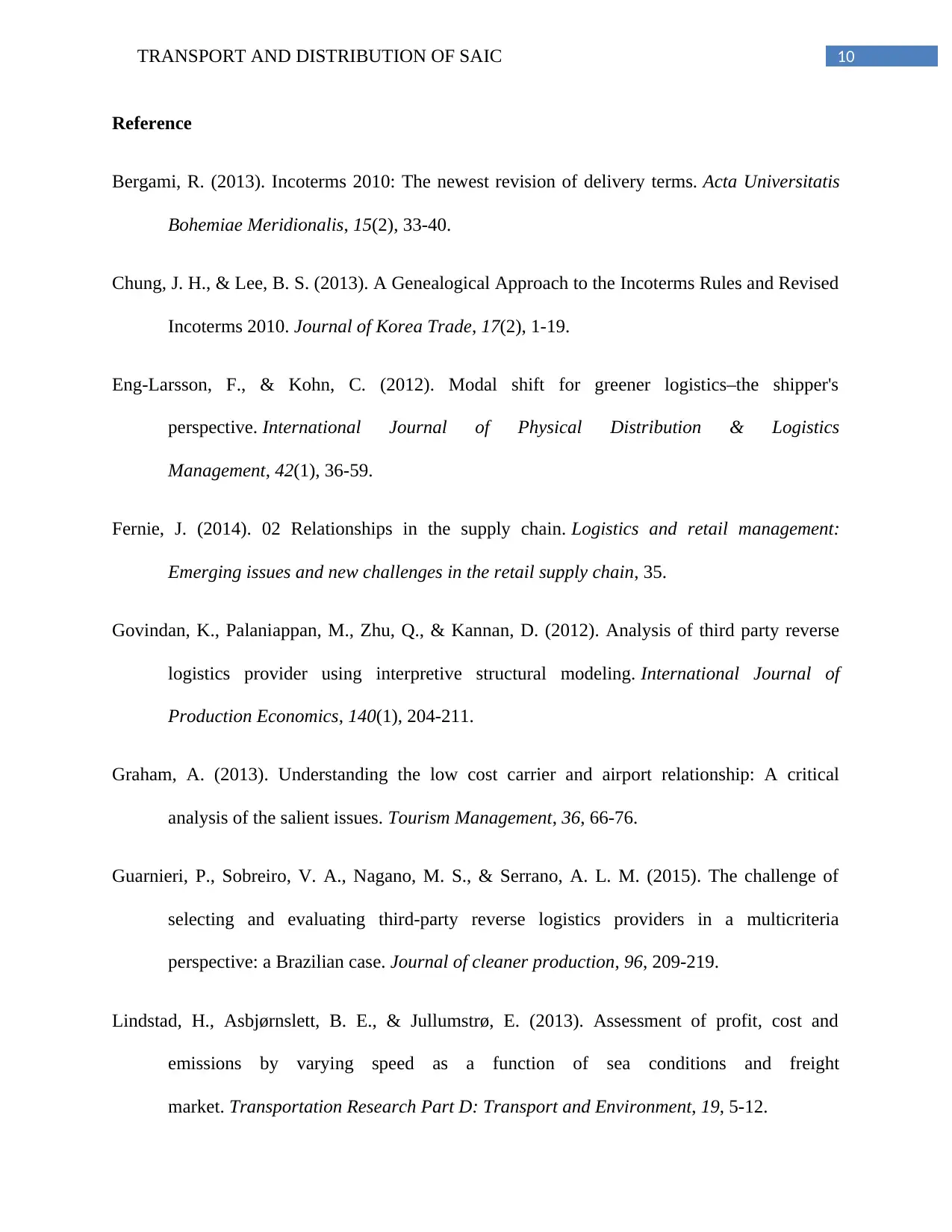
10TRANSPORT AND DISTRIBUTION OF SAIC
Reference
Bergami, R. (2013). Incoterms 2010: The newest revision of delivery terms. Acta Universitatis
Bohemiae Meridionalis, 15(2), 33-40.
Chung, J. H., & Lee, B. S. (2013). A Genealogical Approach to the Incoterms Rules and Revised
Incoterms 2010. Journal of Korea Trade, 17(2), 1-19.
Eng-Larsson, F., & Kohn, C. (2012). Modal shift for greener logistics–the shipper's
perspective. International Journal of Physical Distribution & Logistics
Management, 42(1), 36-59.
Fernie, J. (2014). 02 Relationships in the supply chain. Logistics and retail management:
Emerging issues and new challenges in the retail supply chain, 35.
Govindan, K., Palaniappan, M., Zhu, Q., & Kannan, D. (2012). Analysis of third party reverse
logistics provider using interpretive structural modeling. International Journal of
Production Economics, 140(1), 204-211.
Graham, A. (2013). Understanding the low cost carrier and airport relationship: A critical
analysis of the salient issues. Tourism Management, 36, 66-76.
Guarnieri, P., Sobreiro, V. A., Nagano, M. S., & Serrano, A. L. M. (2015). The challenge of
selecting and evaluating third-party reverse logistics providers in a multicriteria
perspective: a Brazilian case. Journal of cleaner production, 96, 209-219.
Lindstad, H., Asbjørnslett, B. E., & Jullumstrø, E. (2013). Assessment of profit, cost and
emissions by varying speed as a function of sea conditions and freight
market. Transportation Research Part D: Transport and Environment, 19, 5-12.
Reference
Bergami, R. (2013). Incoterms 2010: The newest revision of delivery terms. Acta Universitatis
Bohemiae Meridionalis, 15(2), 33-40.
Chung, J. H., & Lee, B. S. (2013). A Genealogical Approach to the Incoterms Rules and Revised
Incoterms 2010. Journal of Korea Trade, 17(2), 1-19.
Eng-Larsson, F., & Kohn, C. (2012). Modal shift for greener logistics–the shipper's
perspective. International Journal of Physical Distribution & Logistics
Management, 42(1), 36-59.
Fernie, J. (2014). 02 Relationships in the supply chain. Logistics and retail management:
Emerging issues and new challenges in the retail supply chain, 35.
Govindan, K., Palaniappan, M., Zhu, Q., & Kannan, D. (2012). Analysis of third party reverse
logistics provider using interpretive structural modeling. International Journal of
Production Economics, 140(1), 204-211.
Graham, A. (2013). Understanding the low cost carrier and airport relationship: A critical
analysis of the salient issues. Tourism Management, 36, 66-76.
Guarnieri, P., Sobreiro, V. A., Nagano, M. S., & Serrano, A. L. M. (2015). The challenge of
selecting and evaluating third-party reverse logistics providers in a multicriteria
perspective: a Brazilian case. Journal of cleaner production, 96, 209-219.
Lindstad, H., Asbjørnslett, B. E., & Jullumstrø, E. (2013). Assessment of profit, cost and
emissions by varying speed as a function of sea conditions and freight
market. Transportation Research Part D: Transport and Environment, 19, 5-12.
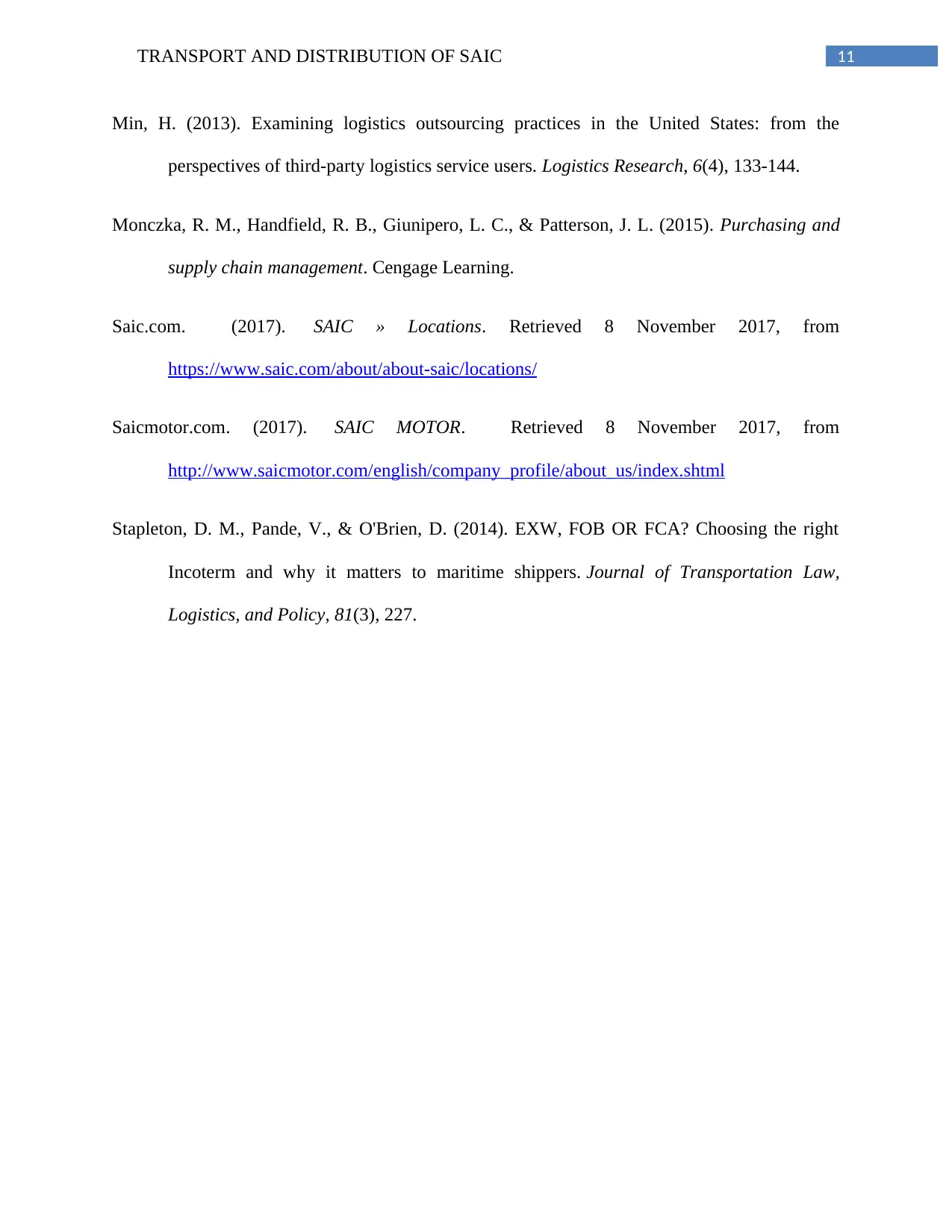
11TRANSPORT AND DISTRIBUTION OF SAIC
Min, H. (2013). Examining logistics outsourcing practices in the United States: from the
perspectives of third-party logistics service users. Logistics Research, 6(4), 133-144.
Monczka, R. M., Handfield, R. B., Giunipero, L. C., & Patterson, J. L. (2015). Purchasing and
supply chain management. Cengage Learning.
Saic.com. (2017). SAIC » Locations. Retrieved 8 November 2017, from
https://www.saic.com/about/about-saic/locations/
Saicmotor.com. (2017). SAIC MOTOR. Retrieved 8 November 2017, from
http://www.saicmotor.com/english/company_profile/about_us/index.shtml
Stapleton, D. M., Pande, V., & O'Brien, D. (2014). EXW, FOB OR FCA? Choosing the right
Incoterm and why it matters to maritime shippers. Journal of Transportation Law,
Logistics, and Policy, 81(3), 227.
Min, H. (2013). Examining logistics outsourcing practices in the United States: from the
perspectives of third-party logistics service users. Logistics Research, 6(4), 133-144.
Monczka, R. M., Handfield, R. B., Giunipero, L. C., & Patterson, J. L. (2015). Purchasing and
supply chain management. Cengage Learning.
Saic.com. (2017). SAIC » Locations. Retrieved 8 November 2017, from
https://www.saic.com/about/about-saic/locations/
Saicmotor.com. (2017). SAIC MOTOR. Retrieved 8 November 2017, from
http://www.saicmotor.com/english/company_profile/about_us/index.shtml
Stapleton, D. M., Pande, V., & O'Brien, D. (2014). EXW, FOB OR FCA? Choosing the right
Incoterm and why it matters to maritime shippers. Journal of Transportation Law,
Logistics, and Policy, 81(3), 227.
⊘ This is a preview!⊘
Do you want full access?
Subscribe today to unlock all pages.

Trusted by 1+ million students worldwide
1 out of 12
Related Documents
Your All-in-One AI-Powered Toolkit for Academic Success.
+13062052269
info@desklib.com
Available 24*7 on WhatsApp / Email
![[object Object]](/_next/static/media/star-bottom.7253800d.svg)
Unlock your academic potential
Copyright © 2020–2025 A2Z Services. All Rights Reserved. Developed and managed by ZUCOL.





